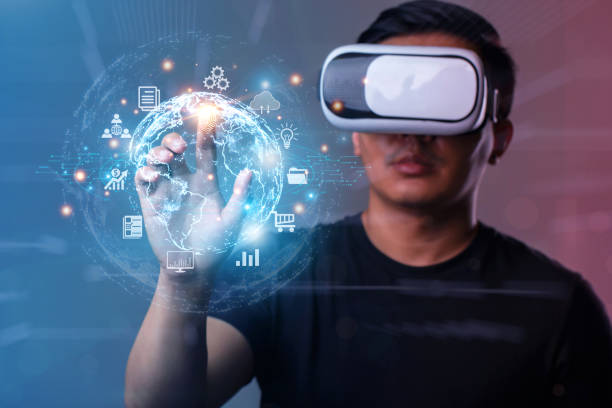AR WEARABLE TECHNOLOGY IN THE INDUSTRIAL METAVERSE.


AR WEARABLE TECHNOLOGY DRASTICALLY CHANGES ORGANISATIONS’ TRAINING AND EDUCATION OF WORKERS IN THE INDUSTRIAL METAVERSE.
Introduction
The terms “wearable technology” and “wearable devices” are frequently used to refer to gadgets and computers that are incorporated into garments and other accessories that can be worn on the body, such as watches and jewellery.
Unless users choose to intentionally keep it off, such devices continually remain in contact with the body. The device has a remote connection, extended battery life, and CPU power. In some situations, the gadgets are more effective at exchanging real-time data than a smartphone or other devices.
Wearable technology over the past 5 years has started to have a significant impact on the fields of commerce and business. The fact that wearable technologies and sensors are starting to appear in national and supranational strategies suggests that they have the ability to drastically alter societies and economies.
These days, wearable technology includes more than simply wristbands. As wearable technology is developed, innovative engineers are coming up with a wide range of novel applications. One of the many emerging industries benefiting from the newest wearable technology is employee training and education.
By developing an immersive, realistic, and on-the-job training experience, AR in training can help to bridge the skill-labour gap and boost employee performance. After all, highly trained workers make for better workers.
Organisations are coping with the widening industrial skills gap as a result of an ageing expert workforce, expanding complexity, outmoded training techniques, and continuous reliance on decades-old machinery in many of today’s companies.
Augmented reality (AR) is being used by best-in-class manufacturers to train and prepare their staff for the future. When the skills they require are rapidly evolving, manufacturers use AR to attract, educate, and empower the next generation of competent workers.
Ways Companies use Wearable AR in Training
A multitude of techniques is used by businesses to integrate wearable technology into creative on-the-job training programs. Among the most inventive are:
Virtual/Remote Onboarding:
As the name implies, virtual or remote onboarding is a remote variation of employee onboarding. It involves each phase of the conventional onboarding process, with various digital tools acting as facilitators (for example, video calls or other collaborative tools like shared documents, etc.). This may include digitally documented processes from retiring workers, that can be pulled up in a worker’s eyepiece as they work hands-free onsite.
This aspect offers an employee an interesting, integrating experience as a member of your company, particularly if they are not in a tangible office location. This is certainly relevant in a hybrid work environment where you want to guarantee that each new hire has an amazing, seamless, and similar experience.
Additionally, this technology allows remote experts to connect with workers on the job to assist with difficult operational queries and bridge the gap between the new and older workforce.
Fully Interactive Training:
Employees can actually “walk into the story” and engage with virtual characters rather than watching a movie while completing questions on a computer. The best part is that you can watch to see how they perform. Additionally, you can load various scenarios for various employees as opposed to having a standardized set of questions that all employees must respond to similarly.
The potential of next-generation technology is harnessed through immersive training to provide on-the-job training programs that are human-centred. They are customized and don’t make the assumption that everyone learns at the same pace or in the same way.
Immersive technologies, such as virtual reality (VR) and augmented reality, merge the actual and virtual worlds when companies use AR in training. The most effective aspects of on-the-job training are enhanced by this technology, including gamified online platforms and skill-specific demonstration videos.
Ways in which Wearable Tech Helps
These are a few ways that wearable technology might assist businesses in providing employees with improved training.
- New product interaction
Employees can engage with a new product in 3D, study specifications while doing so, and view materials rather than just read about it. Employees may present a product to customers with greater assurance the more comfortable they are using it.
- Uniform on-boarding
Wearable AR in training gives you the chance to offer the same training for on-site employees as for remote employees at a time when more and more businesses are hiring remote workers.
- Real-time support
Wearable technology enables managers to provide face-to-face help to an employee when needed without ever departing their desk. And it involves having the capacity to communicate with clients. Wearable technology enables you to interact in a variety of situations in a couple of seconds rather than having to be in three different locations at once.
- Feedback
Employees in training frequently make mistakes that, in some cases, you can’t fix until much later. With the help of feedback functions of wearable technology, you can connect instantly and walk them through the correct process and avoid errors you will have to fix at a later date.
Although instant messaging is useful, when a worker leaves their station, they also stop being able to answer right away. Employees may participate in virtual messaging without being bound to their desks thanks to wearable technology.
Conclusion
Many of the technologies that are currently being developed allow us to move from the classroom to the real world. AR in training is easily making it more effective and immersive, which benefits both businesses and employees.
Wearable technology heavily depends on how easy it is to use. Implementing this as a part of staff training also gives you the opportunity to offer learning that is not constrained by time or geography, opening up a world of opportunities and elevating your company to a completely new level.

